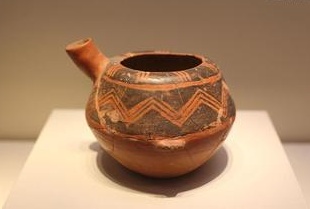(单词翻译:单击)
Dawenkou Culture
大汶口文化
Traces of this culture were first discovered in 1959 along the Dawenhe River near Dawenkou Town of Tai'an Country, and Baotou Village of Ningy- ang County in Shandong Province.
大汶口文化的踪迹1959年时在山东泰安市大汶口村附近的大汶口河以及宁阳县堡头村被首次发现。
Most of the remnants lie around Mount Tai,
大部分遗迹依泰山而存,
reaching as far as the southern coast of the Bohai Sea in the north, Jiangsu Province in the south,
北达渤海南岸,南至江苏省,
the eastern line of the Western Plains of Shandong Province in the west, and the coast of the Yellow Sea in the East.
西至山东省西部平原的东线,东至黄河沿岸。
So far, over 200 remains have been discovered and more than 10 sites (mainly tombs) unearthed.
目前为止,超过200件遗迹已被发现,超过10座遗址(主要为墓穴)被发掘。
Researchers have revealed that the culture lasted mainly from 4300 B.C. to 2500 B.C.
研究者发现大汶口文化主要从公元前4300年持续到公元前2500年。
Ancestors of Dawenkou Culture had polished stoneware as their major production implements,
大汶口文化的祖先打磨石器以作为他们主要的生产工具,
including a large number of exquisite tools of bone, horn and tooth.
其中包括很多精致的由骨头、角和牙齿制成的工具。
Pottery for everyday use was mainly red clay pottery and red sand pottery.
每一天使用的陶器主要为红土陶和红砂陶。
There were gray pottery, black pottery and a small amount of white hard pottery, and colored pottery as well.
同时也有灰陶、黑陶和一小部分的白瓷和彩陶。
During this period, production developed from manual work to wheel work.
在这段时期,生产从手工工作进化为机械工作。
Refined pottery art crafts came into being.
精致的陶艺工艺产生了。
Agriculture constituted their chief economic activity, while fishing and hunting were subsidiary activities.

农业构成了人们主要的经济活动,捕鱼和打猎成为了附属的活动。
Stockbreeding, such as pig, dog, cow, and chicken raising, were rather developed.
畜牧业,比如猪、狗、奶牛和鸡的养殖也在发展。
The handicraft industry of Dawenkou culture had separated itself gradually from agriculture and existed all by itself.
大汶口文化中的手工业使其逐渐脱离农业并形成了自己的文化。
The sharp contrast between the rich and the poor was becoming more and more obvious.
贫富之间的对比越来越明显。
In the late period, there appeared the co-burial of men and women, which marked the social transition from the matriarchy to the patrilineal.
在其文化的最后一段时期出现了男女合葬,而这标着着社会又母系向父系的过渡。


